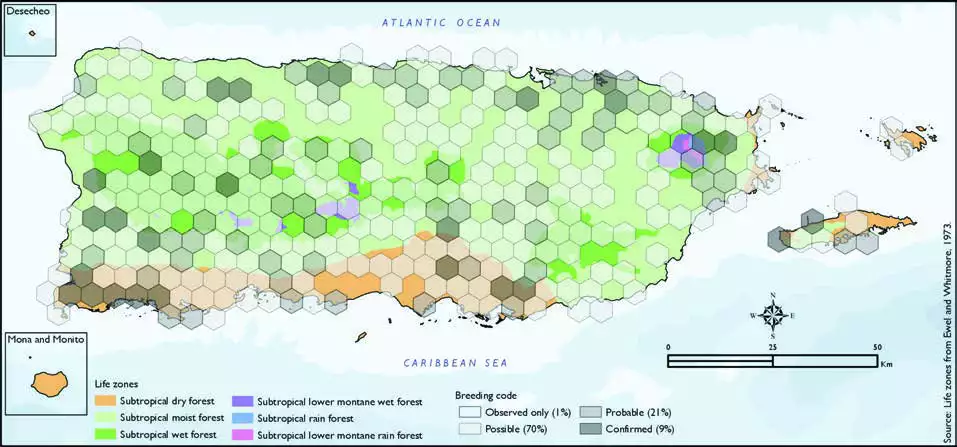Puerto Rican Flycatcher
Description
The Puerto Rican flycatcher (Myiarchus antillarum) is a tyrant flycatcher endemic to the Puerto Rican archipelago and one of the 22 species belonging to the genus Myiarchus of the family Tyrannidae.
Distribution & Habitat
The Puerto Rican Flycatcher is a common endemic species
in Puerto Rico and the Virgin
Islands (Oberle 2018, Raffaele
1989a), a fairly common resident
in Vieques (Gemmill 2015), and
rare in Culebra (Raffaele 1989a).
It is common in wooded habitats
from mangrove edges, arid scrub,
coffee plantations, mogotes,
and montane forests except at
the higher elevations (Oberle
2018, Raffaele 1989a). The atlas
fieldwork yielded a total of 518
records within 302 hexagons
or 63 percent of the 479 total
hexagons (see map). Of the 302
hexagons where this species was found, breeding met the
atlas definition of confirmed in
9 percent (27) of the hexagons,
probable in 21 percent (63),
and possible in 70 percent
(210), while it was observed in
1 percent (2) of the hexagons
but without evidence of breeding
(see map and table). Puerto Rican Flycatcher distribution. The map shows the highest breeding code by hexagon and overlaying the ecological life zones
in Puerto Rico. Note: percentages may not total 100 due to rounding.

Breeding Habits
Previously published reports indicate that the Puerto Rican
Flycatcher nests from February
to July in tree cavities (Oberle
2018). Atlas results indicate that
the breeding season for this
species extends throughout
the year, but breeding activity 207Puerto Rican Flycatcher/Juí de Puerto Ricoincreases from March to June, with a peak in May (see chart).
This seasonal pattern of breeding
appears to coincide in each of
the life zones with no evidence
to suggest breeding times
differ among the life zones.
Results show that the Puerto
Rican Flycatcher breeds in all
ecological life zones, but most
breeding activity was reported
within the subtropical moist,
subtropical wet, and subtropical
dry forest life zones (55 percent,
23, and 21 percent of the
hexagons, respectively) (see
table and map). Breeding was
confirmed in several hexagons located in the interior mountains
in the west and the southwest
coast of the island (see map).
Conservation
Although the Puerto Rican Flycatchers overall population is
believed to be declining owing
to a combination of natural and
anthropogenic habitat loss within
its distribution range (BirdlLife
International 2016), this species
is listed as a species of least
concern by the IUCN (BirdLife
International 2016). Locally, this
species is not listed in any of the
threatened categories of PRDNER and USFWS. It is unknown
if Puerto Rican Flycatcher
populations are limited by cavity
availability as the fl ycatcher does
not make its own cavities for
nesting and hence is dependent
on abandoned woodpecker
cavities or cavities resulting from
natural decay of tree trunks
and branches. In Puerto Rico,
the Puerto Rican Flycatcher has
a protected habitat in land of
about 13 percent (910 km2) of the total area covered by the
hexagons where evidence of
breeding was found for this
species (7223 km2).
Related Species
Family:
flycatcher